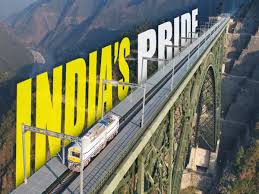
Railway Minister Highlights 8 Key Features of Katra-Srinagar Rail Link

 :
| Updated On: 06-Jun-2025 @ 2:05 pm
:
| Updated On: 06-Jun-2025 @ 2:05 pmSHARE
Following the inauguration of the Katra-Srinagar Vande Bharat Express by Prime Minister Narendra Modi, Railway Minister Ashwini Vaishnaw shared eight significant engineering achievements of the Udhampur-Srinagar-Baramulla Rail Link (USBRL) project through a post on X (formerly Twitter). The USBRL, a key infrastructure development in Jammu and Kashmir, is being hailed as a landmark in modern railway engineering, particularly for its adaptation to the challenging Himalayan terrain.
The minister highlighted that the project includes India’s longest transportation tunnel, designated T-50, which stretches 12.77 kilometers between Khari and Sumber. This feat is a testament to the scale of tunneling involved in navigating the mountainous region.
In addition to T-50, the project also comprises India’s second-longest transportation tunnel, T-80 — also known as the Pir Panjal Railway Tunnel — located between Banihal and Qazigund, and measuring 11.22 kilometers in length. It is followed by T-44, the third-longest railway tunnel in India, which spans 11.13 kilometers between Sawalkote and Sangaldan.
Altogether, the USBRL project includes the construction of 36 main tunnels with a combined length of 119.6 kilometers, and eight escape tunnels totaling 66.4 kilometers. These tunnels were built to withstand the unique geological and seismic conditions of the Himalayan region, using a technique referred to as the Himalayan Tunneling Method — an advanced construction method specifically tailored for such terrain.
One of the most striking engineering marvels of the project is the Chenab Bridge, which is now the world’s highest railway arch bridge. The bridge measures 1.3 kilometers in length and stands 359 meters above the Chenab River — making it 35 meters taller than the Eiffel Tower. The construction of this bridge required over 600 kilometers of steel welding, exceeding the total railway distance from Jammu to Delhi.
The minister also drew attention to the Anji Bridge, India’s first cable-stayed railway bridge. This bridge is 725.5 meters long and is supported by a single central pylon that stands 193 meters high from its foundation. Notably, all 96 stay cables required for the bridge’s structure were successfully installed in just 11 months, with a total cable length of 653 kilometers, which again surpasses the railway distance between Jammu and Delhi.
Another innovative feature of the USBRL project is the all-weather train movement capability. To ensure uninterrupted service even during heavy snowfall, ice-cutters have been installed on the Vande Bharat trains to clear snow from the tracks. This makes the trains more reliable and efficient in harsh winter conditions, enhancing the connectivity of remote and weather-affected areas.
In summary, the USBRL project not only represents a major infrastructure milestone for Jammu and Kashmir but also showcases India's advancing capabilities in complex, high-altitude railway engineering. From record-breaking tunnels and bridges to climate-resilient technology, the project stands as a symbol of modern India's engineering excellence.
Contact Us
House. No. : 163, Second Floor Haridev Rd, near Puberun Path, Hatigaon,Guwahati, Assam 781038.
E-mail : assaminkcontact@gmail.com
Contact : +91 8811887662
Enquiry
×
Reporter Login
×